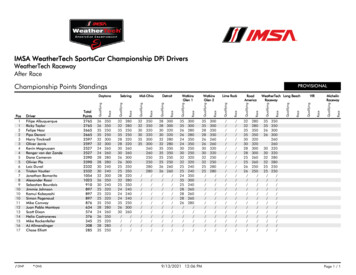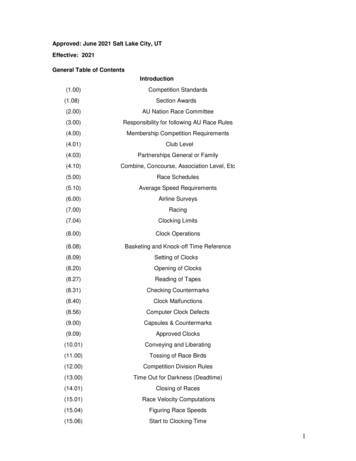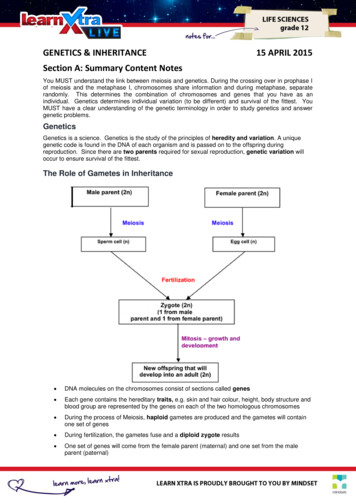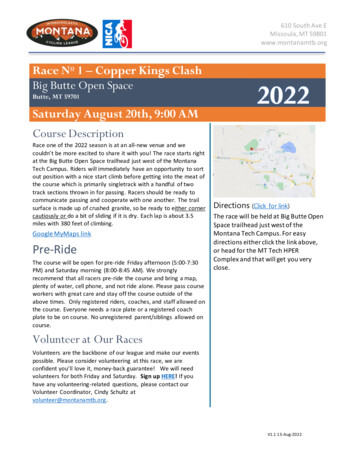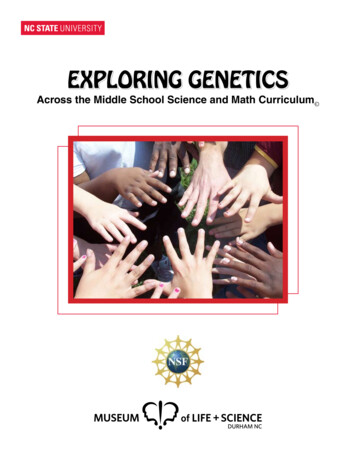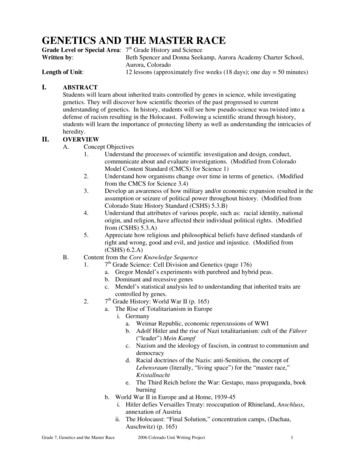
Transcription
GENETICS AND THE MASTER RACEGrade Level or Special Area: 7th Grade History and ScienceWritten by:Beth Spencer and Donna Seekamp, Aurora Academy Charter School,Aurora, ColoradoLength of Unit:12 lessons (approximately five weeks (18 days); one day 50 minutes)I.II.ABSTRACTStudents will learn about inherited traits controlled by genes in science, while investigatinggenetics. They will discover how scientific theories of the past progressed to currentunderstanding of genetics. In history, students will see how pseudo-science was twisted into adefense of racism resulting in the Holocaust. Following a scientific strand through history,students will learn the importance of protecting liberty as well as understanding the intricacies ofheredity.OVERVIEWA.Concept Objectives1.Understand the processes of scientific investigation and design, conduct,communicate about and evaluate investigations. (Modified from ColoradoModel Content Standard (CMCS) for Science 1)2.Understand how organisms change over time in terms of genetics. (Modifiedfrom the CMCS for Science 3.4)3.Develop an awareness of how military and/or economic expansion resulted in theassumption or seizure of political power throughout history. (Modified fromColorado State History Standard (CSHS) 5.3.B)4.Understand that attributes of various people, such as: racial identity, nationalorigin, and religion, have affected their individual political rights. (Modifiedfrom (CSHS) 5.3.A)5.Appreciate how religious and philosophical beliefs have defined standards ofright and wrong, good and evil, and justice and injustice. (Modified from(CSHS) 6.2.A)B.Content from the Core Knowledge Sequence1.7th Grade Science: Cell Division and Genetics (page 176)a. Gregor Mendel’s experiments with purebred and hybrid peas.b. Dominant and recessive genesc. Mendel’s statistical analysis led to understanding that inherited traits arecontrolled by genes.2.7th Grade History: World War II (p. 165)a. The Rise of Totalitarianism in Europei. Germanya. Weimar Republic, economic repercussions of WWIb. Adolf Hitler and the rise of Nazi totalitarianism: cult of the Führer(“leader”) Mein Kampfc. Nazism and the ideology of fascism, in contrast to communism anddemocracyd. Racial doctrines of the Nazis: anti-Semitism, the concept ofLebensraum (literally, “living space”) for the “master race,”Kristallnachte. The Third Reich before the War: Gestapo, mass propaganda, bookburningb. World War II in Europe and at Home, 1939-45i. Hitler defies Versailles Treaty: reoccupation of Rhineland, Anschluss,annexation of Austriaii. The Holocaust: “Final Solution,” concentration camps, (Dachau,Auschwitz) (p. 165)Grade 7, Genetics and the Master Race2006 Colorado Unit Writing Project1
D.c. World War II in the Pacific, and the End of the Wari. Universal Declaration of Human Rights (p. 166)Skill Objectives1.Students use examples to demonstrate that scientific ideas are used to explainprevious observations and to predict future events. (Modified from the CMCSfor Science 1.2)2.Students ask questions and state hypotheses that lead to different types ofscientific investigations. (Modified from the CMCS for Science 1.3)3.Students interpret and evaluate data in order to formulate conclusions. (Modifiedfrom the CMCS for Science 1.6)4.Students will understand the role of genes in heredity. (Modified from theCMCS for Science 3.4.2)5.Students will recognize characteristics of nationalism, militarism, imperialism,and colonialism. (Modified from CSHS 5.3.B)6.Students will compare and contrast philosophies of Nazism, fascism,communism, and democracy by applying information from a chart to scenarioanalyses. (Modified from CSHS 5.3.B)7.Students will summarize the role of anti-Semitism in the history of German Jewsand in the Third Reich. (Modified from CSHS 5.3.A)8.Students will analyze repercussions of censorship by evaluating banned booksand noting literature’s potential as a tool of propaganda. (Modified from CSHS5.3.B)9.Students will discover the horrors of the Holocaust through reading and writing.(Modified from CSHS 5.3.A)10.Students will interpret the rationale behind the “Universal Declaration of HumanRights.” (Modified from CSHS 6.2.A)III.BACKGROUND KNOWLEDGEA.For Teachers1.Bornstein, S. What Makes You Who You Are: A First Look at Genetics.2.Freeman, C. The Rise of the Nazis.3.People’s Century: 1900-1999: 1933 Master Race. (PBS Video)B.For Students1.Grade 6: History: Judaism: central ideas and moral teachings, page 1382.Grade 6: History: Immigration, page 1423.Grade 7: History: World War I, p. 1624.Grade 7: History: America from the Twenties to the New Deal, page 1645.Grade 7: Language Arts: Autobiography, Diary of a Young Girl (Anne Frank),page 161IV.RESOURCESA.Very helpful for the students’ understanding: Prentice Hall Cells and Heredity (LessonsOne and Three)B.The Night Spies, Kathy Kacer (All Lessons)C.Number the Stars, Lois Lowry (All Lessons)D.Hana’s Suitcase, Karen Levine (All Lessons)V.LESSONSLesson One: Who is Gregor Mendel? (50 minutes)A.Daily Objectives1.Concept Objective(s)a.Understand how organisms change over time in terms of genetics.2.Lesson Contenta.Gregor Mendel’s experiments with purebred and hybrid peas.Grade 7, Genetics and the Master Race2006 Colorado Unit Writing Project2
b.Dominant and recessive genesSkill Objective(s)a.Students will understand the role of genes in heredity.Materials1.Student copies of Appendix A: Gregor Mendel and his peas!2.Prentice Hall book on Cells and Heredity or other book covering Gregor Mendeland genetics.Key Vocabulary1.Covered in Appendix A.Procedures/Activities1.Today the students start their study of genetics. If you teach out of the PrenticeHall series of science books you are going to read from chapter 3, section 1, inthe Cells and Heredity book. If you do not use this series, Appendix A hasdefinitions and facts that should be covered with the students.2.Hand out copies of Appendix A: Gregor Mendel and his peas to the students.The students should fill this out after reading about Gregor Mendel.3.Read and discuss with the students section 1 from the book, make sure that theyhave a strong understanding of what recessive and dominant alleles are.4.Once you are done reading have the students fill in the definitions and facts aboutGregor Mendel.Assessment/Evaluation1.Student’s completion of Appendix A, page 1 and 2. You can collect and grade orjust do a quick check for completion.3.B.C.D.E.Lesson Two: Let’s take a survey (50 minutes)A.Daily Objectives1.Concept Objective(s)a.Understand the processes of scientific investigation and design, conduct,communicate about and evaluate investigations.b.Understand how organisms change over time in terms of genetics.2.Lesson Contenta.Dominant and recessive genes3.Skill Objective(s)a.Students ask questions and state hypotheses that lead to different types ofscientific investigations.b.Students interpret and evaluate data in order to formulate conclusions.B.Materials1.Student copies of Appendix B, page 1: Let’s take a survey2.Overhead of Appendix B, page 4: Let’s take a survey data table (enlarged)C.Key Vocabulary1.Recessive allele is the allele that becomes masked if a dominant allele is present.2.Dominant allele is the allele that always shows up if it is present for that gene.D.Procedures/Activities1.Today the students are going to take a survey of the class. This survey is goingto be of some of the traits that are visual for us to see.2.Pass out appendix B: Let’s take a survey, to the students.3.Tell the students that today that they are going to be taking a pole, but first theyare going to predict and form a hypothesis before beginning.4.Students should answer questions 1 and 2.5.Once students are done answering questions 1 and 2, they need to pair up with apartner. This partner will help them to correctly fill in the chart.6.Tell the students that they are now going to fill in the data table provided forthem. They are to help their partner out with traits that they may not be able tosee. They are to then circle which trait they have for the certain category. AnGrade 7, Genetics and the Master Race2006 Colorado Unit Writing Project3
E.example is for row A, the two traits are trait 1: free ear lobe and trait 2: attachedear lobe. If they have an attached ear lobe then they need to circle attached earlobe on their sheet. Give the students 5-10 minutes to fill in their data table.Once students are done they should return to their seats.7.Once every student has returned to their seat it is now time to take theirindividual information and put it in as a class. Take Appendix B, page 4 theenlarged data table and put it on the overhead. Go through each row and havethe students raise their hands for the trait that applies to them. Count the numberof hands for each trait and put that number in the column that applies. Continueuntil the whole chart is filled in.8.Once the whole chart is filled in discuss/predict with the class which traits theythink are dominant and which are recessive. Ask them to explain how they arecoming up with their predictions. (Many students will say that the higher numberof students in a category means dominant and the lower number meansrecessive.)9.After you are done discussing as a class, inform the students that all of the traitsin the trait 1 column are dominant and all the traits in the trait 2 column arerecessive. This should throw the students off a bit, because some of the recessivetraits should have shown up as the majority of the class.10.Have the students finish filling out Appendix B questions 3-6.Assessment/Evaluation1.Student’s completion of Appendix B, page 1 and 2 should be turned in for agrade.Lesson Three: Punnett Squares, Probability and Genetics (50 minutes)A.Daily Objectives1.Concept Objective(s)a.Understand how organisms change over time in terms of genetics.2.Lesson Contenta.Dominant and recessive genesb.Mendel’s statistical analysis led to understanding that inherited traits arecontrolled by genes.3.Skill Objective(s)a.Students use examples to demonstrate that scientific ideas are used toexplain previous observations and to predict future events.b.Students interpret and evaluate data in order to formulate conclusions.c.Students will understand the role of genes in heredity.B.Materials1.Teacher copy of Appendix C, page 1: Teacher Notes2.Student copies of Appendix C, page 2 and 3: Punnett SquaresC.Key Vocabulary1.Covered in Appendix C, page 1D.Procedures/Activities1.Today the students are going to further their understanding of genetics andinheritance. Before you begin briefly review dominant and recessive alleles,what they are, how they are represented (lower/upper case lettering), etc.2.If you teach out of the Prentice Hall series of science books you are going to readfrom chapter 3, section 2, in the Cells and Heredity book. If you do not use thisseries refer to Appendix C, page 1 to help allow your student to have all of theinformation needed.3.Note that if you do have the Prentice Hall series; make sure that you also coverbriefly with your students, after you are done reading section 2, chromosomes. .4.Once the students are finished reading pass out Appendix C, page 2 and 3:Punnett Squares.Grade 7, Genetics and the Master Race2006 Colorado Unit Writing Project4
5.E.Have the students fill out the worksheet, if they do not have enough time to finishin class then assign the worksheet for homework.Assessment/Evaluation1.Student’s completion of Appendix C, page 2 and 3, should be turned in for agrade.Lesson Four: Alien Babies (50 minutes)A.Daily Objectives1.Concept Objective(s)a.Understand the processes of scientific investigation and design, conduct,communicate about and evaluate investigations.b.Understand how organisms change over time in terms of genetics.2.Lesson Contenta.Dominant and recessive genesb.Mendel’s statistical analysis led to understanding that inherited traits arecontrolled by genes.3.Skill Objective(s)a.Students ask questions and state hypotheses that lead to different types ofscientific investigations.b.Students interpret and evaluate data in order to formulate conclusions.a.Students will understand the role of genes in heredity.B.Materials1.Scissors2.Paper Plate3.Large Marshmallows4.Shock tarts5.Mini Chocolate Chips6.Jelly Beans7.Toothpicks8.Wire9.Red and blue pipe cleaners10.Blue and black markers11.Student copies of Appendix D, pages 1, 2, 3, 4 and 5: Alien BabiesC.Key Vocabulary1.Chromosomes are genes that are carried from parents to offspring.2.Phenotype is the physical appearance (tall, short).2.Genotype is the allele combination (TT, Tt, tt)3.Homozygous is having two identical alleles for a particular trait (TT or tt).4.Heterozygous is having two different alleles for a particular trait (Tt).D.Procedures/Activities1.Today the students are going to construct their own Alien Babies.2.Teachers should have all of the materials needed for the Alien Babies preparedprevious to class.3.When the students arrive review with them what chromosomes are, along withthe Punnett Square, probability, phenotype, genotype, homozygous andheterozygous.4.After the brief review with the students, pass out Appendix D, page 3, 4 and 5.5.Read through the procedure on page 3 with the class.6.Students should then be paired up into groups of two.7.Once in groups of two pass out Appendix D, page 1 and 2, the chromosomesheets, making sure that in each group there is a dad chromosome sheet and amom chromosome sheet. Hint: It is helpful to run the sheets off in two differentcolors to help distinguish the two. For example the dad’s sheets can be blue andGrade 7, Genetics and the Master Race2006 Colorado Unit Writing Project5
E.the mom’s sheets can be pink. This makes it much easier to see if every grouphas one of each kind of sheet.8.After every group has their chromosome sheets the students may begin, makingsure to follow the procedure on Appendix D, page 3.Assessment/Evaluation1.Student’s completion of Appendix D, pages 4 and 5 should be turned in for agrade.Lesson Five: Family Tree Pedigree (50 minutes)A.Daily Objectives1.Concept Objective(s)a.Understand the processes of scientific investigation and design, conduct,communicate about and evaluate investigations.b.Understand how organisms change over time in terms of genetics.2.Lesson Contenta.Dominant and recessive genesb.Mendel’s statistical analysis led to understanding that inherited traits arecontrolled by genes.3.Skill Objective(s)c.Students use examples to demonstrate that scientific ideas are used toexplain previous observations and to predict future events.d.Students ask questions and state hypothesis that lead to different types ofscientific investigations.e.Students interpret and evaluate data in order to formulate conclusions.a.Students will understand the role of genes in heredity.B.Materials1.Student copies of Appendix E, page 1, 2 and 3: Family Portrait2.Construction paper3.Rulers4.MarkersC.Key Vocabulary1.Pedigree is a family tree that charts a particular trait.D.Procedures/Activities1.Note: Teachers you will want to pass out Appendix E, page 1 and 2 prior to thestart of this lesson so that students can go home and fill in the sheet with theirfamilies.2.Beginning today the students are going to make their own pedigree chart withinformation that they have gathered about their own family.3.Students should have out Appendix E, page 1 and 2, on their desks.4.Ask the students what a family tree is. Most students should answer that it issomething that traces your family back in history.5.After talking about what a family tree is go on to a family pedigree. Discuss withstudents that a family pedigree is like a family tree; the only difference is that afamily pedigree tracks certain traits.6.With the students do an example family pedigree with them, you may chose to doyour own family or just make one up.7.While you are going over a family pedigree make sure that you are explainingthat males are represented by a square and females are represented by a circle.Also, let them know that if a person is married to or has offspring with the personthen a horizontal line that goes from the middle of the circle to the middle of thesquare connects them. For siblings a vertical line and a bracket connect them.This line should go down from the middle of the parents and then the bracketsshould go off from there. If the person has the dominant trait they are going to beGrade 7, Genetics and the Master Race2006 Colorado Unit Writing Project6
E.colored in and if the person has the recessive trait they are not going to becolored.8.Once you have gone over the pedigree chart with your students pass outAppendix E, page 3, the rubric, and go read over it with the students.9.The students may begin working once the rubric has been gone over.Assessment/Evaluation1.Students’ completion of the project will be scored on Appendix E, page 3.Lesson Six: Test over Genetics (50 minutes)A.Daily Objectives2.Concept Objective(s)a.Understand the processes of scientific investigation and design, conduct,communicate about and evaluate investigations.b.Understand how organisms change over time in terms of biologicalevolution and genetics.3.Lesson Contenta.Gregor Mendel’s experiments with purebred and hybrid peas.b.Dominant and recessive genesc.Mendel’s statistical analysis led to understanding that inherited traits arecontrolled by genes.4.Skill Objective(s)a.Students interpret and evaluate data in order to formulate conclusions.b.Students will understand the role of genes in heredity.B.Materials1.Student copies of Appendix F, page 1, 2 and 3C.Key Vocabulary1.NoneD.Procedures/Activities1.Pass out Appendix F, page 1, 2 and 3 to the students. The students will be giventhe hour to complete the test. They should work individually on their test.E.Assessment/Evaluation1.Students’ completion of Appendix F, page 1, 2 and 3 should be turned in for agrade.Lesson Seven: The Weimar Republic (one 50-minute class period)A.Daily Objectives4.Concept Objective(s)a.Develop an awareness of how military and/or economic expansionresulted in the assumption or seizure of political power throughouthistory. (Modified from (CSHS) 5.3.B)5.Lesson Contenta.History: World War II1.The Rise of totalitarianism in Europea. Germanyi. Weimar Republic, economic repercussions of WWI6.Skill Objective(s)a.Students will recognize characteristics of nationalism, militarism,imperialism, and colonialism. (CSHS) 5.3.B)B.Materials3.Appendix G: Initial Assessment, two copies for each student4.Appendix H: Discussion Notes, a transparency, plus a few paper copies5.Appendix I: The Weimar Republic, paper copies for each student6.Appendix J: Bibliography of Holocaust Fiction, a paper copy to post in theclassroomGrade 7, Genetics and the Master Race2006 Colorado Unit Writing Project7
C.D.E.Key Vocabulary2.Nationalism is holding the belief that one’s national culture and interests aresuperior to any other nation or group.3.A policy in which military preparedness is of primary importance to a state ismilitarism.4.Imperialism is the policy of extending a nation's authority by territorialacquisition.5.Colonialism is the economic philosophy of taking over nations for resources andstrategic position.Procedures/Activities5.Tell students they will not earn a low grade for the opener work sheet. You wantto see how much they remember about the “isms” of World War I. Pass outAppendix G Initial Assessment. Students should define the terms on the sheetwithout resources or conversation.6.When they are finished, collect the sheets. Go over the terms, asking fordefinitions. Assure them that analyzing these abstract terms is difficult and youare going to review them today.7.Pass out another copy of Appendix G: Initial Assessment. Put Appendix H:Discussion Notes, the transparency, on the overhead projector. Have students fillin their second copy with the information on the overhead. To accommodatestudents with special needs, hand out photocopies of the notes.8.Keep some spare paper copies of Appendix H: Discussion Notes for studentswho are absent.9.This lesson continues with a review of World War I causes. Pass out and readover Appendix I: The Weimar Republic with students.10.Focus on nationalism and tell students it will be important for them to have thesenotes to refer to, in an effort to understand Germany in the 1930’s.11.Reinforce with students that Germany was a disaster from World War I. Theeconomy was bad, farm production had suffered, (nitrates used for fertilizer werediverted to ammunition production during the war) and people were vulnerable.This made it possible for a dictator to take over.12.This may be a good time to interject the some current events: discuss withstudents what life is like in Iraq during the war years. Some comparisons may bemade about people losing homes, etc.13.Share with students that they will be choosing a book to read for this unit. PostAppendix J Bibliography of Holocaust Fiction, introducing a few titles.14.The school library may have many of these books. This is a sampling of juvenileand young adult books on the Holocaust.15.To accommodate students with special needs, there is a wide range of readinglevels in the books on this list. Some are picture books and some are at the youngadult level, with reading levels in between throughout the list.16.You may check out books at the public library and have a room set to choosefrom; however, do no allow students to take these books out of the classroom.17.Set aside some reading time for students to delve into Holocaust fiction. Therewill be a book sharing class for students to discuss their reading.18.There are many other titles to choose from; students need not be limited tosuggestions from the list.19.Encourage students to search library databases in the school library and in thepublic library under the heading, “Holocaust—juvenile fiction.”20.Make sure you approve the book they choose for this assignment.Assessment/Evaluation2.Review Appendix G: Initial Assessment sheets that students did in the beginningof class. This initial assessment will help direct future instruction as to the levelGrade 7, Genetics and the Master Race2006 Colorado Unit Writing Project8
of understanding and retention students are having to complex philosophies.Award up to ten points for effort in defining the terms.Lesson Eight: Nazis and Totalitarianism (two 50-minute class periods)A.Daily Objectives1.Concept Objective(s)a.Develop an awareness of how military and/or economic expansionresulted in the assumption or seizure of political power throughouthistory. (CSHS 5.3.B)2.Lesson Contenta.Adolf Hitler and the rise of Nazi totalitarianism: cult of the Führer(“leader”) Mein Kampfb.Nazism and the ideology of fascism, in contrast to communism anddemocracy3.Skill Objective(s)a.Students will compare and contrast philosophies of Nazism, fascism,communism, and democracy by applying information from a chart toscenario analyses. (CSHS) 5.3.B)B.Materials1.Appendix K: Chart Notes: Nazis and Totalitarianism, paper copies for students2.Appendix L: Who Am I? for each student3.Appendix M: Notes: Nazis and Totalitarianism, paper copies for students4.Appendix N: Sample Parent Letter, copies go home before Lesson ThreeC.Key Vocabulary1.A totalitarian government exerts absolute control over all aspects of life.2.Nazism is a dictatorship adhering to national racism and forcible expansion.3.Fascism is a dictatorship using war, terror, censorship, and racism to controlpeople.4.Communism is a theory for an economic system of collective ownership for allmembers’ advantage; but, in practice, it attracts strict authoritarian government.5.A democracy is a government by the people; the people hold the power.D.Procedures/Activities11.This lesson presents some difficult concepts of government and economies.Discuss the word totalitarian with students and explain that many dictatorialregimes come under this heading.12.Pass out Appendix K: Chart Notes: Nazis and Totalitarianism, to each student.Have them look over the information on the sheet.13.Tell them they will work in groups of three or four students for this exercise.Explain that they will play “Who Am I?” while becoming familiar with the fourconcepts on the sheet. Pass out Appendix L: Who Am I? to each student.14.Arrange students in groups to work on this assignment. Give groups time to readthe selections and assess the correct responses.15.To accommodate students with special needs, ensure that group membershipallows for paired reading between high-level students and those who will find theassignment too challenging to manage alone. Collect responses when complete.16.Go over the correct answers found on Appendix L: Who Am I? page 4, andcheck for understanding.17.Homework: Students should select a novel on the Holocaust, from the list inclass or another teacher-approved title. They should be reading this book forhomework and during any free time in class.18.Day 2: Hitler and the Versailles Treaty will be the topic for today. Review thematerial from Lesson One, particularly the meaning of nationalism.19.Pass out copies of Appendix M: Notes: Nazis and Totalitarianism.20.Discuss with them the maniacal drive of Adolf Hitler once he became chancellor.Grade 7, Genetics and the Master Race2006 Colorado Unit Writing Project9
21.E.Discuss how Hitler was able to gain so much power in such a short period oftime. (Aging President Paul von Hindenburg was senile; he sometimes thoughtHitler was Kaiser Wilhelm. Hitler got the Enabling Law passed; this eliminatedany control from the Reichstag, or parliament. Then, the intimidation began; theSS and Gestapo (secret police) were formed and began terrorizing people.)22.Go over all the notes on this handout. Students may want to highlight points oradd additional notes. Have them keep Appendix M: Notes to study later on.23.Pass out copies of Appendix N: Sample Parent Letter, to each student. Read thisover with them. Tell them that tomorrow we are going to wear X’s in an effort tounderstand how the outcasts of Germany felt.24.Homework: Read books on the HolocaustAssessment/Evaluation1.Evaluate Appendix L Who am I? papers. Check with the KEY, page 4 ofAppendix L. Assess work at two points each, for a total of twenty possiblepoints for an assessment to monitor progress.Lesson Nine: The Master Race (two 50-minute class periods)A.Daily Objectives1.Concept Objective(s)a.Understand that attributes of various people, such as: racial identity,national origin, and religion, have affected their individual politicalrights. (Modified from (CSHS) 5.3.A)2.Lesson Contenta.Racial doctrines of the Nazis: anti-Semitism, the concept of Lebensraum(literally, “living space”) for the “master race,” Kristallnacht3.Skill Objective(s)b.Students will summarize the role of anti-Semitism in the history ofGerman Jews and in the Third Reich. (CSHS) 5.3.A)B.Materials1.Appendix O: Master Race X’s, copied on red paper and cut out, one X for eachstudent2.Appendix P: Notes: The Master Race paper copies for each student3.Appendix Q: How to Take Notes, on a transparencyC.Key Vocabulary1.Aryan, to Nazis, meant a non-Jewish Caucasian, a member of the master race.2.Anti-Semitism is hostility, prejudice, or discrimination towards Jews or Judaism.3.A ghetto was a walled quarter in a European city in which Jews were restricted.D.Procedures/Activities1.Ask students if they shared Appendix N: Sample Parent Letter, with theirfamilies. Review the reason that X’s will be worn today. (so students canunderstand how it may have felt to be persecuted)2.Pass out an X, cut from Appendix O, to each student and have him or her wear iton his or her shirt, attached with tape or a pin.3.These are not to be decorated, colored, beautified, or altered in any way. Informthem that for one day, we will try to understand how it must have felt to be madeto wear a yellow star because of our religion, have our arms branded with serialnumbers for life, and ridiculed, or worse.4.Treat students with less kindness than usual, because of the X’s. Do not gooverboard on this as it quickly becomes apparent that it’s very effective inbecoming an attack on their dignity.5.Pass out Appendix P: Notes: The Master Race. Read over with students andencourage discussion. Remind students that there is not a textbook that covers allthis material so you will be giving them notes. They need to save all the notes tocreate a study guide for the final test.Grade 7, Genetics and the Master Race2006 Colorado Unit Writing Project10
6.E.Tell students you are aware of the volume of information that is included in thishandout. Tell them you will help them condense the material into notes that canbe studied at a glance for future review. Reinforce to them that you are helpingthem make it easier to learn the information.7.Put the transparency of Appendix Q: How to Take Notes, on the overhead andreveal one section at a time. Show students how to bullet important details intwo-column notes.8.To accommodate students with special needs, copies of Appendix Q: How toTake Notes, can be available as paper copies to study. Extra copies will also behelpful for students who are absent for this activity.9.They can follow your examples or condense the paragraphs on their own. Tellthem their two-column notes will be collected for credit.10.While focusing on condensing material into notes from paragraph form, studentsare reviewing material read and reinforcing learning.11.Have students retain the original Appendix P: The Master Race, for future study.They can remove their X’s at the end of class. Discuss how the X’s made themfeel.12.Tell them Jewish people in Nazi Germany had to wear yellow stars to helpidentify them as an inferior race and eventually, as a mark to exterminate thoseindividuals wearing them.13.Two days are allowed for this material because there is so much information. Ifthere is time left over on Day Two, studen
("leader") Mein Kampf c. Nazism and the ideology of fascism, in contrast to communism and democracy d. Racial doctrines of the Nazis: anti-Semitism, the concept of Lebensraum (literally, "living space") for the "master race," Kristallnacht e. The Third Reich before the War: Gestapo, mass propaganda, book burning b. World War II in .


